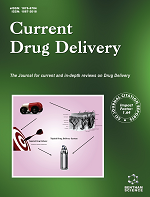- Home
- A-Z Publications
- Current Drug Delivery
- Previous Issues
- Volume 21, Issue 9, 2024
Current Drug Delivery - Volume 21, Issue 9, 2024
Volume 21, Issue 9, 2024
-
-
A Review on Novel Applications of Nanotechnology in the Management of Prostate Cancer
More LessAuthors: Arshi Khanam, Gurvirender Singh, Smita Narwal, Bhawna Chopra and Ashwani K. DhingraBackground: Prostate cancer continues to be a serious danger to men's health, despite advances in the field of cancer nanotechnology. Although different types of cancer have been studied using nanomaterials and theranostic systems derived from nanomaterials, they have not yet reached their full potential for prostate cancer due to issues with in vivo biologic compatibility, immune reaction responses, accurate targetability Read More
-
-
-
Deciphering the Therapeutic Applications of Nanomedicine in Ovarian Cancer Therapy: An Overview
More LessAuthors: Pooja Mathur, Shailendra Bhatt, Suresh Kumar, Sweta Kamboj, Rohit Kamboj, Arpana Rana, Harish Kumar and Ravinder VermaThe majority of deadly cancers that afflict the female reproductive system occur in the ovary. Around 1,40,000 women worldwide die from ovarian cancer each year, making it the sixth most common cancer-associated deceases among females in the United States. Modern, cutting-edge treatments like chemotherapy and surgery frequently produce full remissions, but the recurrence rate is still very high. When this crippli Read More
-
-
-
A Comprehensive Review on Imperative Role of Ionic Liquids in Pharmaceutical Sciences
More LessAuthors: Prerna Uniyal, Shibam Das, Surbhi Panwar, Neelima Kukreti, Pankaj Nainwal and Rohit BhatiaIonic liquids (ILs) are poorly-coordinated ionic salts that can exist as a liquid at room temperatures (or <100 °C). ILs are also referred to as "designer solvents" because so many of them have been created to solve particular synthetic issues. ILs are regarded as "green solvents" because they have several distinctive qualities, including better ionic conduction, recyclability, improved solvation ability, low volatility, and therm Read More
-
-
-
3D Printed Personalized Colon-targeted Tablets: A Novel Approach in Ulcerative Colitis Management
More LessUlcerative colitis (UC) and Crohn's disease (CD) are two types of idiopathic inflammatory bowel disease (IBD) that are increasing in frequency and incidence worldwide, particularly in highly industrialized countries. Conventional tablets struggle to effectively deliver anti-inflammatory drugs since the inflammation is localized in different areas of the colon in each patient. The goal of 3D printing technology in pharmaceutics is to cre Read More
-
-
-
Cellulose Acetate-Based Wound Dressings Loaded with Bioactive Agents: Potential Scaffolds for Wound Dressing and Skin Regeneration
More LessAuthors: Sindi P. Ndlovu, Sibusiso Alven, Kula Hlalisa and Blessing A. AderibigbeWound healing and skin regeneration are major challenges in chronic wounds. Among the types of wound dressing products currently available in the market, each wound dressing material is designed for a specific wound type. Some of these products suffer from various shortcomings, such as poor antibacterial efficacy and mechanical performance, inability to provide a moist environment, poor permeability to oxygen and cap Read More
-
-
-
Nanoformulations Insights: A Novel Paradigm for Antifungal Therapies and Future Perspectives
More LessAuthors: Ashima Ahuja and Meenakshi BajpaiCurrently, fungal infections are becoming more prevalent worldwide. Subsequently, many antifungal agents are available to cure diseases like pemphigus, athlete’s foot, acne, psoriasis, hyperpigmentation, albinism, and skin cancer. Still, they fall short due to pitfalls in physiochemical properties. Conventional medications like lotion, creams, ointments, poultices, and gels are available for antifungal therapy but present Read More
-
-
-
Investigation of Antioxidant and Anti-inflammatory Properties of Berberine Nanomicelles: In vitro and In vivo Studies
More LessIntroduction: In the present study, neuroprotective effects of berberine (BBR) and berberine nanomicelle (BBR-NM) against lipopolysaccharides (LPS)-induced stress oxidative were investigated, and compared by evaluating their antioxidant and anti-inflammatory activities in PC12 cells, and rat brains. A fast, green, and simple synthesis method was used to prepare BBR-NMs. Method: The prepared BBR-NMs were then charac Read More
-
Volumes & issues
-
Volume 22 (2025)
-
Volume 21 (2024)
-
Volume 20 (2023)
-
Volume 19 (2022)
-
Volume 18 (2021)
-
Volume 17 (2020)
-
Volume 16 (2019)
-
Volume 15 (2018)
-
Volume 14 (2017)
-
Volume 13 (2016)
-
Volume 12 (2015)
-
Volume 11 (2014)
-
Volume 10 (2013)
-
Volume 9 (2012)
-
Volume 8 (2011)
-
Volume 7 (2010)
-
Volume 6 (2009)
-
Volume 5 (2008)
-
Volume 4 (2007)
-
Volume 3 (2006)
-
Volume 2 (2005)
-
Volume 1 (2004)
Most Read This Month
Article
content/journals/cdd
Journal
10
5
false
en

Most Cited Most Cited RSS feed
-
-
Preface
Authors: Deng-Guang Yu and He Lv
-
- More Less

